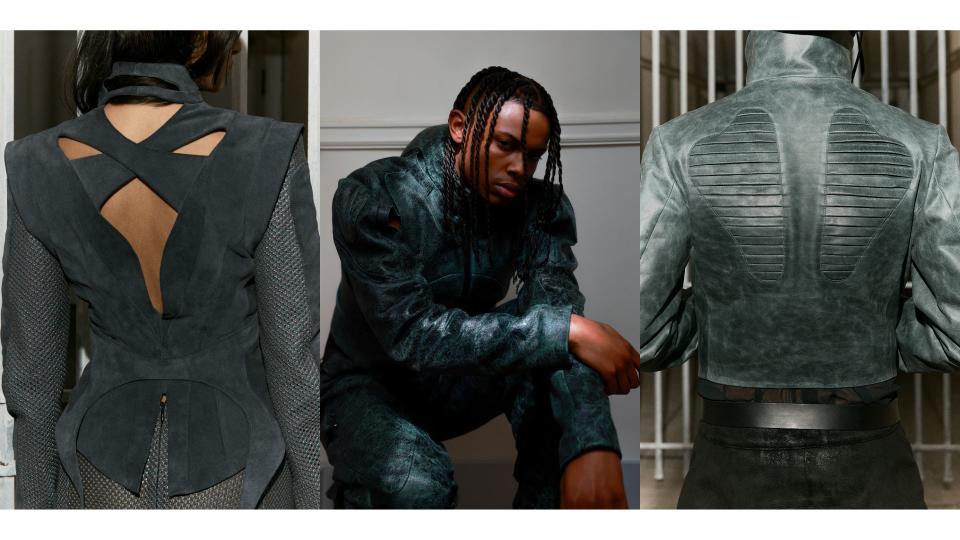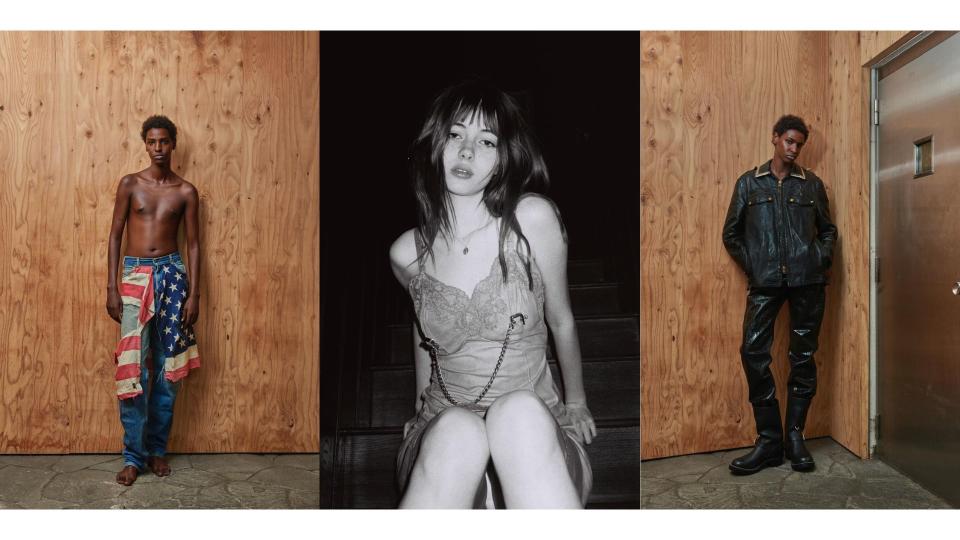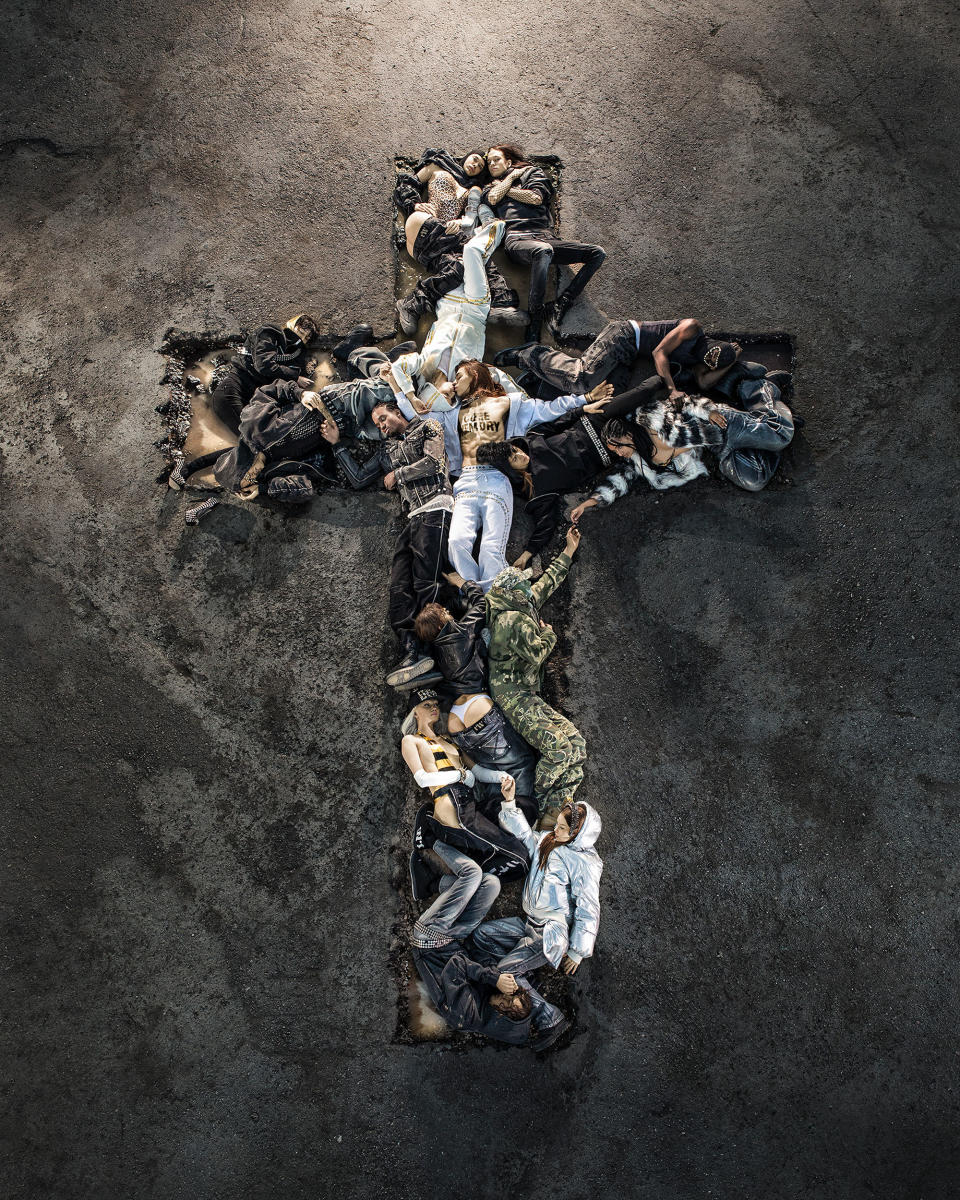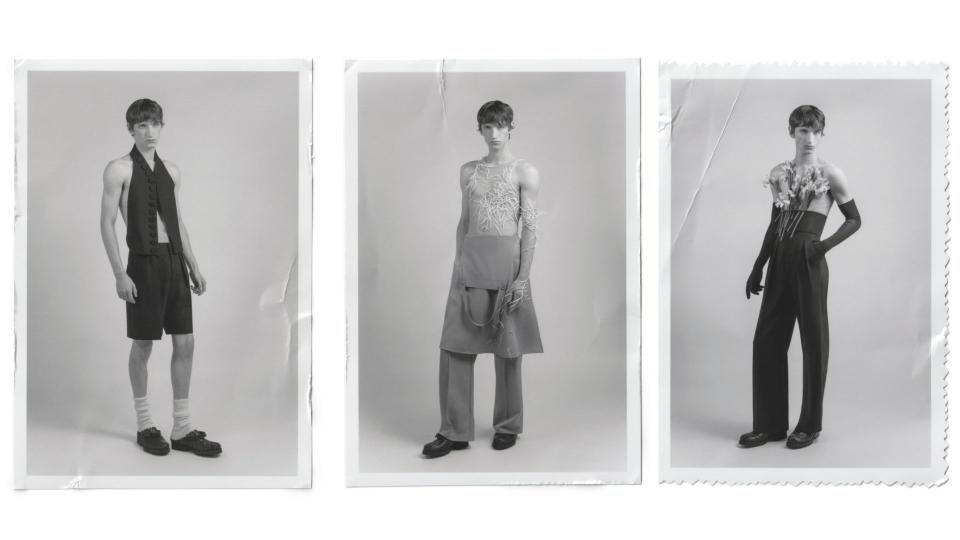The Designers and Brands to Watch for Paris Men’s Week for Spring 2025

The nomadic wisdom of ancestors from Central Asia, a finsta becoming a brand filled with creative experiments, a Gen Z success story from Estonia and men’s tailoring inspired by countryside women are some of the ideas cropping up in Paris for the spring 2025 men’s week.
Yenesai
“I feel that any brand that was born during COVID times can outlive anything,” joked Yenesai founder Meerim Chotbaeva.
More from WWD
In fact, her two-year-old label that blends technical fabrics, futuristic aesthetics and techniques like 3D printing with her Central Asia roots was born twice, in 2019 and 2022.
A finance graduate who works in sports media trading TV rights, London-based Chotbaeva started experimenting with custom motorcycling gear for herself in the runup to the pandemic.

“I love riding bikes but unfortunately, the riding gear is very ugly, so I started making my own,” she recalled. “Then I came to the understanding that if I made more jackets than one [for myself], I could have access to better fabrics and tap into this whole network of suppliers.”
She named the label Yenesai, nodding to the Yenisey river network that flows northward toward the Arctic Ocean and originates in Siberia.
“This is where my ancestors are from. When we were still nomadic, we would just travel around it and the translation of its name means ‘mother river,’” said Chotbaeva.
But the 2019 mini-capsule, full of Kevlar and stab-resistant fabrics, didn’t hit the spot in her opinion.
Finally launched digitally at the end of 2022, the range taps into the learnings of a life always on the go, with patterns meant to contour the body and protect it without constraining it.
In keeping with the nomadic ethos of clothes that serve a wearer’s changing needs by being adaptable, Chotbaeva also uses fabrics with properties such as UV protection, water repellence and are easy-wash, easy-care. “So if you’re traveling, you just chuck it into your bag and you’re just going to put it on and look good in it,” she added.
Produced in Italy and Romania with textiles sourced in Japan for the most part, Yenesai is priced between 90 euros for a body-skimming performance top up to 1,500 euros for a 72-piece armor-paneled jacket.
After depicting the arrival of space-faring nomads on a distant planet in January, her spring 2025 collection will be looking at the hard-knock life of the exploring settler in an unknown environment.
And there’s another new environment Chotbaeva is keen to explore: Sardinia. In addition to moving her design studio to the Mediterranean island, she is in the process of opening an artist retreat with music recording facilities and other installations.
Marking Distance
Marking Distance started out as Lukka Sabbat’s “finsta,” or Fake Instagram, an account he started in 2020 solely to document his life through photographs and drawings without having his name attached to it. It garnered its own following when the “Grown-ish” star and model started posting projects such as furniture.
It turned into a label almost two years later, after he connected with James Pierce, a New York-based designer who cut his teeth by working a range of jobs before landing an internship at Interview Magazine and alongside stylist and costume designer Mimi Fischer.
After meeting on the social network – Sabbat bought a hat Pierce made and kicked off a conversation about working together – the pair started dabbling in clothing, repurposing vintage clothing – theirs or thrifted finds – and skewing toward the very experimental with treatments that ranged from slathering heavy black tar used on roofing on denim and stitching using dental floss to burying clothing in the ground to see how they’d evolve.

When the time came to give a name to their project, Marking Distance felt ideal. “I think it encapsulates the way we get inspiration from so many different places and things, whether it’s the craft punk culture in New York, Japanese streetstyle, raving in Berlin,” said Sabbat. “Our clothes are marking the distance between all our inspirations that are based on real things – cultures and places – that inspire us from all around the world. None of our references come from clothing.”
Turning their initial pieces into a commercially viable line required what Pierce deemed “a wild road trip” that took them from Japan to Italy and through the workshops of specialist manufacturers. Expect retooled utility clothing and Americana staples, given unusual washes, tweaked proportions and a lived-in vibe.
For its inaugural offering, Marking Distance skews 90 percent toward menswear and offers a range that spans tops, bottoms, denim, leathers, outerwear and footwear as well as a handful of accessories. Only jewelry and leather goods have been left off for now.
“There’s a huge influence from vintage military clothing in the collection,” said Pierce, pointing out a retooled trench coat. “My grandfather was in the military, and I used a vintage military coat that my dad had given me years ago to make the initial sample. Taking something with so much history and making it mine was really special,” he said.
Asked the price point, Sabbat quipped that the range “ain’t cheap” given the handwork and finishings involved. Jokes aside, the duo are adamant about keeping to a price point that will be congruent with the brand’s budding community.
“We’re trying to make things accessible but there are things that will be inevitably expensive from just the treatments,” said Sabbat. “But we are going to price things accordingly and fairly. We are a new brand. We understand that we’re coming into the market and we want things to be fair.”
Racer
How do you go from a basement in Tallinn, the capital of Estonia, to a runway in Paris, fashion’s capital?
If streetwear label Racer is anything to go by, you find a clutch of likeminded friends in high school, you get together to throw some underground parties, you start making merch repurposing utility garments.
Founder and creative director Mihhail Zigadlo explained this all started with a desire to express “a vision on the world from a vacuum of Eastern Europe,” growing up with parents still under the shadow of the Soviet Union.
“The mentality was that everything that came from abroad was interesting and we just copied it because we couldn’t do our own as we had no cultural background or layered history we could build upon,” he explained over Zoom.
Racer’s subcultural cocktail of skateboarding, street art and music struck a chord with their peers, who flocked to its merch-turned-fashion line. So much so that by the time Zigadlo headed to university to study international business, that side-hustle had grown to the point where he dropped out to work on developing the brand full time.

According to the brand, it’s shifted some 35,000 products last year across all categories, mostly to an 18-to-24 years old “Gen Z” demographic.
Designed in-house and sold direct-to-consumer, the brand’s prices start at under 100 euros for t-shirts and shorts, without breaking the 300-euro barrier even for leather jackets and outerwear.
And seven years after it started, the brand is ready to shake things up once more.
First with their Paris debut show, for which they enlisted Anna Himma, their compatriot best known for her work with rapper Tommy Cash.
Then by partially pivoting away from the direct-to-consumer model.
“We have an intention to maybe pick up the more traditional [seasonal] schedule, with showrooms in future,” said Zigadlo, calling the show an experiment. “We still really want to emphasize on the public and on direct-to-consumer.”
But there’s one thing Racer’s never letting go: its grassroots approach.
“We really prioritize being understandable to our strong young community,” Zigadlo continued. “If you can dress the whole city in something, this proves a point much more than dressing one celebrity in an editorial.”
Meyer
“The traditional approach to clothing is the only way of creating clothes with a limited impact on the environment and respects the people who work on them,” said designer Lucas Meyer. “It’s a question of scale but also of quality and durability.”
A handmade approach underpins Meyer, his eponymous tailoring label now on its third collection.
The 29-year-old first studied design and applied arts at the University of Strasbourg before heading to Paris to pursue menswear at Atelier Chardon Savard, followed by a course in tailoring at Institut Français de la Mode.
Between the two, he worked at Opéra National du Rhin, where he worked on Renaissance-era costumes for a production of “Queen Margot.”

“The costume designer really wanted us to use techniques that were as close as possible to the [original] ones so it meant very little [use of] machines, much hand-sewing and traditional interfacing,” he said. “So my first real relationship to clothing construction was an artisanal one.”
His own label started in 2020 as a way to hone his skills, while working at Ludovic de Saint Sernin and later Maison Alaïa. “It was an obsession about techniques, about the handwork I wanted to practice that I didn’t always have the opportunity to use where I was working,” he said.
And despite sketching dresses for as long as he can remember as a child, he applied those to menswear. “Fashion always has to do with the body and brings [you] back thinking about your own body and your own identity,” he said.
His work draws inspiration from his countryside upbringing and the folklore of his native region and for now, he only presents one lineup a year, a practical choice that also fits the slow and steady approach he favors.
For his 2025 collection of 12 looks, he blended the wardrobe of rural women with a bygone idea of couture, turning elements like a practical apron tied at the waist into an elegant overlay to tailored trousers or a Sunday-best coat into a cool blouson with oversized buttons.
Price-wise, tailored jackets start around 800 euros and coats can go up to 2,000 euros. The line’s current best seller is a t-shirt with a heart-shaped openwork detail in the back, nodding to traditional Alsatian wooden chairs, that retails for 130 euros.
Also popular are his made-to-measure tulle singlets, which can go over 1,500 euros when embroidered with feathers shaped like grass, ears of wheat or other vegetal motifs.
Best of WWD


